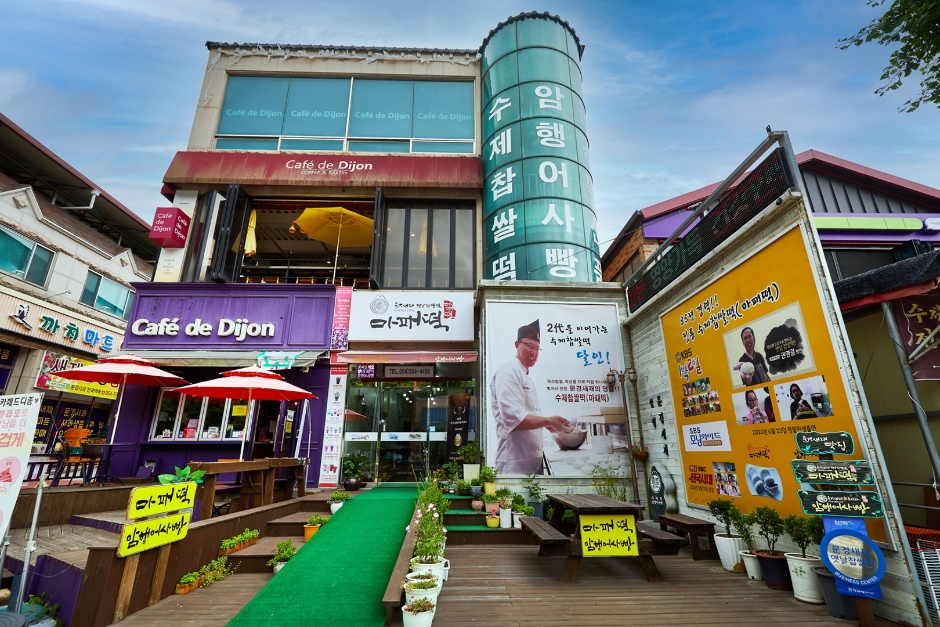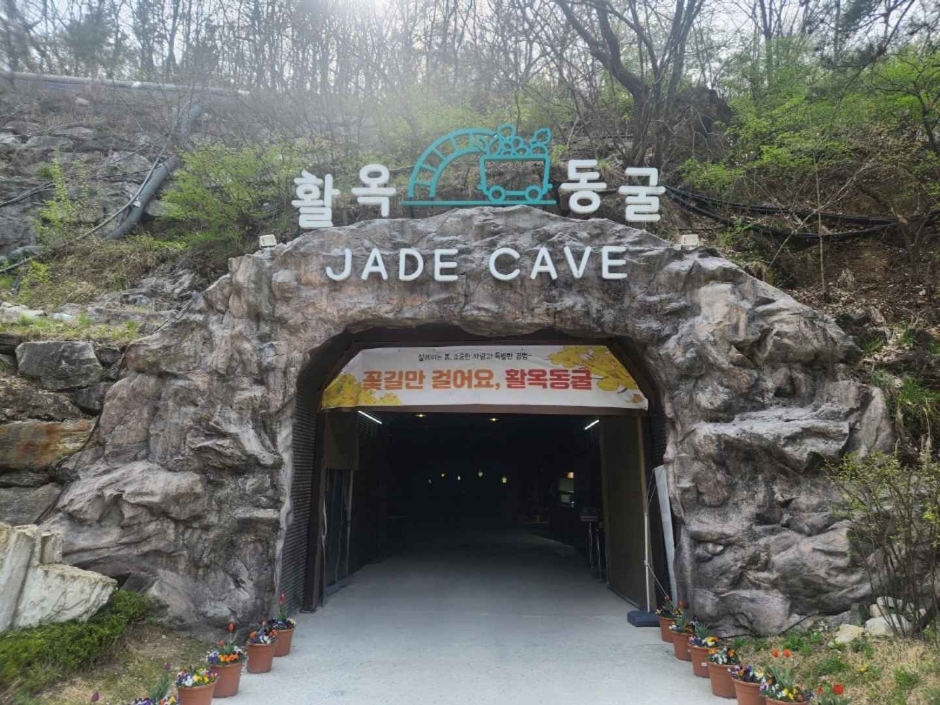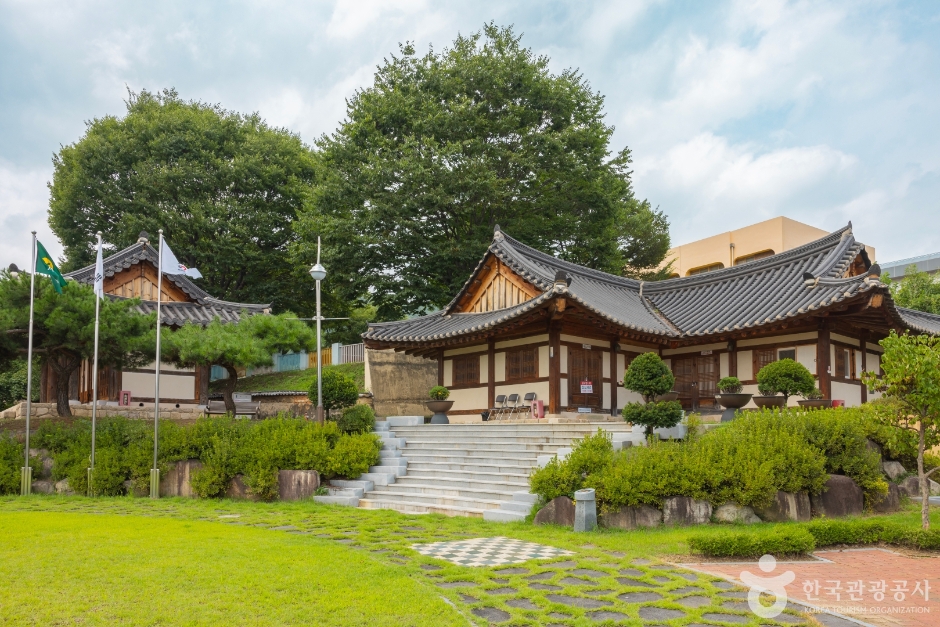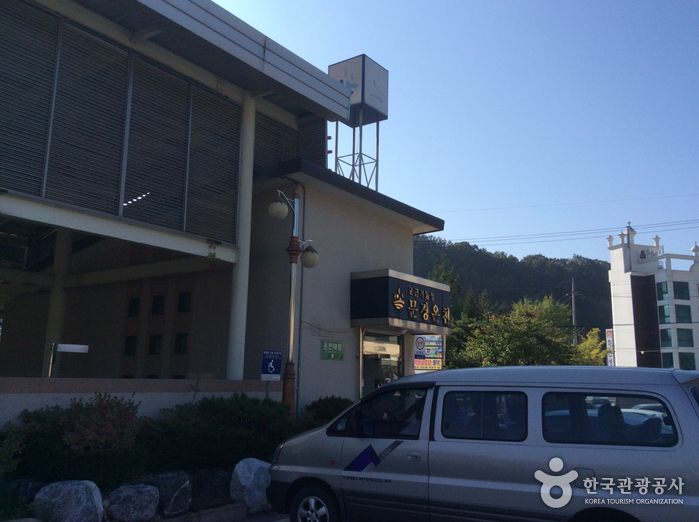Mungyeongsaejae Yetnal Chapssal Tteok (문경새재옛날찹쌀떡)
11.5Km 2024-03-18
914 Saejae-ro, Mungyeong-eup, Mungyeong-si, Gyeongsangbuk-do
Located in the parking lot of Mungyeongsaejae Provincial Park, this place serves handmade sweet rice cakes made from red beans and glutinous rice. Horse Warrant Rice Cake, made in a traditional way without using preservatives, is not too sweet and has crispy nuts in it. In the Joseon dynasty, inspectors used horse warrants to commandeer horses for their missions to rural areas. Figures of horses were drawn differently depending on the grade. In particular, these were used to identify secret imperial inspectors who were dispatched to rural areas and secretly carried out inspection duties. You can also taste Secret Royal Inspector Bread made with Omija marmalade from Mungyeong. Word of mouth spreading at Mungyeongsaejae Pass makes it highly recommended to visit early, as it is likely to be sold out early.
Mungyeong Yakdol Hanu Town (문경약돌한우타운)
13.4Km 2025-10-23
2426 Mungyeong-daero, Mungyeong-eup, Mungyeong-si, Gyeongsangbuk-do
+82-1588-9075
Mungyeong Yakdol Hanu Town is a meat processing facility and restaurant built by Mungyeong City to promote the excellence of Mungyeong Yakdol Hanu, a local specialty, throughout the country. The restaurant is highly recommended as a must-visit place for sightseeing in Mungyeong because of its large space (1 underground floor, 2 above-ground floors) and high-quality Korean beef. The Korean beef raised on pegmatite (a rock that contains beneficial minerals to the human body), also known as "medicine stone" or yakdol in Korea, is known to have a superior taste because it contains low-fat content and is good for your health. Guests can also visit Mungyeong Yakdol Korean Beef butcher shop, which sells Korean beef at half the market price. In addition to grilled meat, there are also many dishes such as bulgogi hot pot, bibimbap, and cold buckwheat noodles.
Chungju Hwalok Cave (충주 활옥동굴)
13.8Km 2025-03-16
26 Mokbeoran-gil, Chungju-si, Chungcheongbuk-do
Developed in 1922 during the Japanese Forced Occupation, this is the only talc mine in Korea and is the largest in the East, with a recorded length of 57km, an unofficial length of 87km, and an underground vertical x_height of 711m. A 2.5km-long stretch of the cave has been developed into a tourist site, filled with light sculptures, performance venues, and health therapy zones. LED, neon, and a variety of natural lights create a mysterious atmosphere, and since the temperature stays between 11 and 15 degrees year-round, it's even more popular in summer. There is also a kayaking experience that allows visitors to see inside the cave by kayaking in a lake created by mineral water.
Note that the temperature inside the cave averages between 11 and 15 degrees Celsius, which is warm in the winter but cold in the summer, so you'll want to bring a long-sleeved jacket.
Cheongungak Hall (청운각)
13.9Km 2023-10-20
35 Cheongun-ro, Mungyeong-si, Gyeongsangbuk-do
Cheongungak Hall was the living quarters for President Park Chung Hee from 1937 to 1940 while he was working as an elementary school teacher. After becoming president, he would often visit the hall when there were events in the area of Mungyeong. Cheongungak Hall was built in 1928 and is a prime example of 20th century architecture. Currently the hall serves as an exhibition space for photos of the president and items he used during his time here.
OmyNara (오미나라)
14.0Km 2023-08-02
609 , Saejae-ro, Mungyeong-si, Gyeongsangbuk-do
20 years of passion for OmyRose
OmyNara is an Omija winery that manufactures wine using traditional fermentation methods and oak barrel maturation methods using eco-friendly Omija originating in Korean soil. OmyNara also operates various experience programs such as winery tours and making your own commemorative wine, as well as various educational programs such as wine etiquette and basic courses on making authentic sparkling wine. Visit OmyNara guided tour of the winery and enjoy various experiences such as learning about the wine-making process and tasting wine.
Yeonpung Sanctuary (연풍성지)
14.3Km 2024-02-26
14, Jungang-ro hongmun 2-gil, Yeonpung-myeon, Goesan-gun, Chungcheongbuk-do
After the nationwide repression of Catholicism in 1791, a group of Catholics came to what is today known as Yeonpung Sanctuary to practice their religion in secret before they were discovered and executed in 1801. Today, Yeonpung Sanctuary is a Catholic sanctuary dedicated to the martyrs. Yeonpung Sanctuary has a Catholic church, a crucifix, and a sculpture and tomb of Hwang Seokdu (Luke; 1813-1866), a saint born in Yeonpung and martyred as a Catholic.
Korea Tea Cup Museum (한국다완박물관)
14.5Km 2023-10-20
2-1 Oncheon 5-gil, Mungyeong-si, Gyeongsangbuk-do
The Korea Tea Cup Museum opened in March of 2022 as the first museum dedicated solely to displaying dawon, traditional tea cups. The museum displays around 700 cups from the past to modern times, while maintaing over 2,500 tea cups in storage for rotational exhibitions. The museum is operated by Kim Seon-sik, an eight-generation potter. A range of experience programs is available with advance reservation.
Mungyeong Spa (문경종합온천)
14.7Km 2023-04-07
24, Oncheon 2-gil, Mungyeong-eup, Mungyeong-si, Gyeongsangbuk-do
+82-54-571-2002
Mungyeong Spa is an enormous hot springs complex that first opened in March 2001 and is able to accommodate up to 2,500 visitors at one time, as well as up to 1,000 vehicles in the spacious parking lot.
It offers two types of hot springs water. The yellow earth-colored hot springs water comes from 900 meters underground and the other hot springs water comes from 750 meters below the ground.
Mungyeong Flying Land (문경활공랜드)
14.8Km 2025-10-23
80 Hwalgongjang-gil, Mungyeong-si, Gyeongsangbuk-do
+82-1599-5623
Mungyeong Flying Land, a top paragliding facility, is conveniently located in Mungyeong, which offers excellent conditions for this amazing sport. Mungyeong’s geographic features create an excellent updraft and steady winds, and the area’s total absence of high-tension wires provides plenty of open space for a safe landing. Paragliding at this site offers a spectacular view thanks to the several mountain terrains that surround the area. There also many tourist attractions nearby such as Mungyeong Spa, Mungyeongsaejae Pass, and more.
Jecheon Oksunbong Suspension Bridge (제천 옥순봉 출렁다리)
14.9Km 2022-04-08
342, Oksunbong-ro, Jecheon-si, Chungcheongbuk-do
+82-43-641-6738
Near one of Korea's Scenic Spot, Oksunbong Peak, Oksunbong Suspension Bridge provides visitors with a thrill stretching 222 meters long, 1.5 meters wide. The Deck Road and trekking trail made of palm tree mat completes the total length of 944 meters. Visitors can also easily get to Cheongpungho Lake and Oksunbong Peak.






 English
English
 한국어
한국어 日本語
日本語 中文(简体)
中文(简体) Deutsch
Deutsch Français
Français Español
Español Русский
Русский